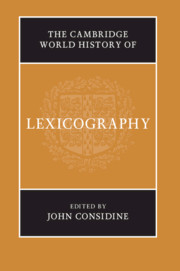Book contents
- The Cambridge World History of Lexicography
- The Cambridge World History of Lexicography
- Copyright page
- Contents
- Contributors
- Editor’s Acknowledgements
- Introduction
- Part I The Ancient World
- Part II The Pre-Modern World
- 6 China, c. 600–c. 1700
- 7 India and Tibet, c. 500–c. 1750
- 8 Arabic to c. 1800
- 9 Hebrew to c. 1650
- 10 The Chinese Periphery to c. 1800
- 11 The Turkic Languages and Persian to c. 1700
- 12 Byzantine Greek
- 13 Medieval Latin Christendom
- 14 Early Modern Western and Central Europe
- Part III The Modern World: Continuing Traditions
- Part IV The Modern World: Missionary and Subsequent Traditions
- Appendix 1 The Language Varieties
- Appendix 2 The Lexicographers
- Primary Sources
- Secondary Sources
- Index
8 - Arabic to c. 1800
from Part II - The Pre-Modern World
Published online by Cambridge University Press: 01 September 2019
- The Cambridge World History of Lexicography
- The Cambridge World History of Lexicography
- Copyright page
- Contents
- Contributors
- Editor’s Acknowledgements
- Introduction
- Part I The Ancient World
- Part II The Pre-Modern World
- 6 China, c. 600–c. 1700
- 7 India and Tibet, c. 500–c. 1750
- 8 Arabic to c. 1800
- 9 Hebrew to c. 1650
- 10 The Chinese Periphery to c. 1800
- 11 The Turkic Languages and Persian to c. 1700
- 12 Byzantine Greek
- 13 Medieval Latin Christendom
- 14 Early Modern Western and Central Europe
- Part III The Modern World: Continuing Traditions
- Part IV The Modern World: Missionary and Subsequent Traditions
- Appendix 1 The Language Varieties
- Appendix 2 The Lexicographers
- Primary Sources
- Secondary Sources
- Index
Summary
Interest in philology by the Arabs is reported in the sources to have begun only a few decades after the Qurʾān had been revealed to Prophet Muḥammad. The Hegira of Muḥammad from Mecca to Medina in AD 622 marks the beginning of the Islamic calendar, and thus the first century after the Hegira (AH) corresponds to the seventh century AD. But it is not until the second half of the second/eighth century that the earliest works in both grammar and lexicography were authored. Sībawayhi’s al-Kitāb laid the foundations of the grammatical tradition, and most later authors were faithful to its analytical methods, arguments, terminology, and scope. Sībawayhi was deeply influenced by his teacher al-Ḫalīl b. Aḥmad, himself the author of the first (non-thematic) Arabic lexicon, Kitāb al-ʿAyn. But although grammar and lexicography became two distinct disciplines at a very early stage, they shared much of their material and were both closely related to other linguistically oriented sciences, such as qirāʾāt (Qurʾānic readings), Ḥadī (Prophetic tradition), fiqh (jurisprudence), and tafsīr (exegesis).
- Type
- Chapter
- Information
- The Cambridge World History of Lexicography , pp. 159 - 181Publisher: Cambridge University PressPrint publication year: 2019



